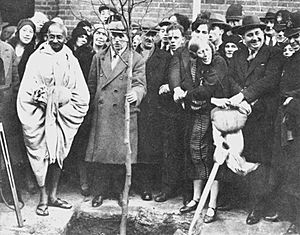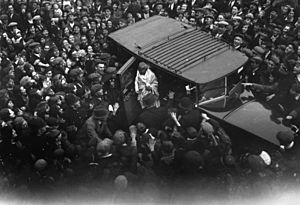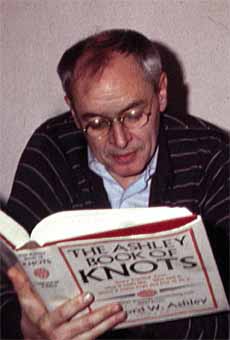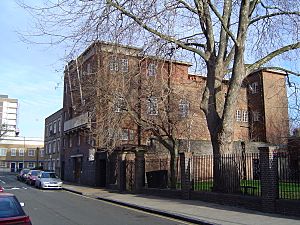Kingsley Hall facts for kids
Quick facts for kids Kingsley Hall |
|
|---|---|
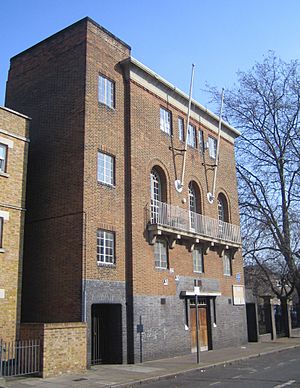
Kingsley Hall (front view) in Bromley-by-Bow, also home of the Gandhi Foundation
|
|
| Location | Powis Road, Bromley-by-Bow, London, England |
| Area | London Borough of Tower Hamlets |
| Built | 1928 |
| Architect | Charles Cowles-Voysey |
| Architectural style(s) | Neo-Georgian style |
| Governing body | Charitable Trust |
|
Listed Building – Grade II
|
|
| Designated | September 1973 |
| Reference no. | 1357884 |
Kingsley Hall is a community center located in Bromley-by-Bow, East End of London. It was started by two sisters, Doris and Muriel Lester, who had a nursery school nearby. Their brother, Kingsley Lester, passed away in 1914. He left money to help the local community with "educational, social, and recreational" activities. The sisters used this money to buy and fix up an old chapel.
The current Kingsley Hall building was officially started on July 14, 1927. The sisters later built a second community center, also called Kingsley Hall, in Dagenham.
During the General Strike in 1926, Kingsley Hall in Bow became a safe place. It offered shelter and food to workers. Later, in 1931, Mahatma Gandhi stayed at Kingsley Hall. The building now hosts the Gandhi Foundation. The room where he stayed is still kept as it was. In 1935, people on the Jarrow March, who were protesting unemployment, also stayed at the Hall.
In 1965, a famous psychiatrist named R. D. Laing and his team used Kingsley Hall. They wanted to try new ways of helping people with mental health challenges. It became a place for a special experiment in psychology. The idea was to help people without using medicine or strict rules.
Kingsley Hall was recognized as a Grade II listed building in September 1973. This means it's an important historical building.
Contents
The Start of Kingsley Hall
Doris, Muriel, and Kingsley Lester came from a wealthy family. However, they had a strong connection to the poorer parts of East London. Their grandfather, Henry Lester, grew up very poor. He started working as a bricklayer's helper when he was just eight years old. Their father, also named Henry Lester, began working at the Thames Ironworks at age ten. He later owned a ship repair yard and helped pay for his children's early social work. Both their father and grandfather were devoted Baptists.
Henry Lester bought a small house in Loughton, a countryside area at the time. It was named Rachel Cottage after his late wife. This cottage was used as a holiday spot for families from Bow and for nursery children.
In 1912, Doris and Muriel Lester opened a Nursery School. Children received food, clothes, and care for a small fee. If mothers couldn't pay, wealthier supporters helped cover the costs. Soon, they added activities for older groups. Their goal was to help people grow in mind, body, and spirit. They wanted to bring everyone together, no matter their background.
Kingsley Lester passed away in 1914. He left his money for "educational, social, and recreational" activities in Bow. In 1915, Doris and Muriel Lester bought an old chapel. Local volunteers helped decorate and set it up. It became known as Kingsley Hall, a "people's house." Here, friends, neighbors, workers, and children gathered for "worship, study, fun, and friendship." It had a nursery, social events, concerts, and an adult school. Football, Sunday services, and summer holiday programs also began.
The center's goals were written on membership cards. They said it was "a place of fellowship." People could meet for social, educational, and fun activities. There were "no barriers of class, color, or creed."
During World War I, Doris and Muriel remained against war. Kingsley Hall ran a soup kitchen and stayed open at night for Air Raid Wardens. After the war, they marched to the House of Commons. They asked for milk to be sent to Germany, where people were starving. The members of Kingsley Hall even adopted a German child. They paid for her to stay with a local family for two years.
After the war, Kingsley Hall kept strong ties with the Suffragettes in East London. These activists fought for women's right to vote. Muriel Lester spoke on street corners and in Victoria Park. People who heard her talks often donated to help Kingsley Hall. Muriel became an Alderman in the local government. She fought for basic needs like milk for young children.
Enough money was saved to build the Children's House on Bruce Road. H. G. Wells opened it in 1923. The foundation stones had special meanings like Vision, Nature, and Education. The Children's House still operates as a Nursery School today.
The Powis Road Building
During the 1926 General Strike, Kingsley Hall became a shelter and soup kitchen for workers. The Hall became very popular, and a larger building was needed. A new Kingsley Hall was built on Powis Road. Funds came from local people and wealthy supporters. Charles Cowles-Voysey was the architect.
A special ceremony took place on July 14, 1927. Many people laid bricks, each representing a different idea. For example, Sir Walford Davies laid the brick of MUSIC. Sybil Thorndike laid the brick of DRAMA. John Galsworthy laid the brick of LITERATURE. These bricks showed the many different purposes of the new Hall.
Kingsley Hall on Powis Road opened on September 15, 1928. The building had small living spaces, a clubroom, a dining room, a kitchen, an office, and a space for worship.
Gandhi's Stay
Just a few years after it opened, the new building welcomed its most famous visitor. In 1931, Mahatma Gandhi accepted an invitation to stay there. He was in London for talks about the future of India. He stayed in a small bedroom on the roof. When the weather was good, he even slept outside on the roof.
Lylie Valentine, who worked at the nursery, wrote about Gandhi's visit. She described the excitement in East London: "When he arrived, I think all the people in East London waited outside to see him." "...he spent a lot of time with us. He visited the Nursery School and all the children called him Uncle Gandhi. At six o'clock each morning, after his prayers, he took his walk along the canal, talking to workmen on the way.... There was something about him that always lives with the people."
Gandhi's daily walk started before dawn and lasted about an hour. He walked quickly, exploring the local area, especially along the Lea and the canal. He enjoyed walking along the Sewerbank (now called the Greenway). This path gave him great views. Crowds of people, including many children, would join him. They were eager to talk to him about many topics. Sometimes, he would visit local homes.
Muriel Lester noted that Gandhi easily connected with the local people. She said, "He always enjoyed the swift repartee of Cockney wit. He was never at a loss for a reply in the same vein."
Gandhi lived at Kingsley Hall for 12 weeks. He also visited Kingsley Hall's Dagenham site. Stories that he brought a goat were just made up by the press. Many famous people visited Gandhi at Kingsley Hall. These included Charlie Chaplin, George Bernard Shaw, and the Pearly King and Queen of East London.
Gandhi loved East London, and the people there loved him back. When he left, he wrote in the visitor book: "Love surrounded me here."
Later, Muriel Lester joined Mahatma Gandhi on a trip to areas in Bihar, India, that were affected by an earthquake. She also joined his tour against untouchability in 1934.
In 1954, English Heritage placed a Blue plaque on the building. This plaque honors Gandhi's stay there.
The Jarrow Marchers
In 1935, Ellen Wilkinson led the Jarrow March to London. This was a protest by unemployed men from Jarrow. Some of these men stayed at Kingsley Hall. It was a case of people who had little helping others who had even less. The community collected small amounts of money and opened a jumble sale to help the marchers.
Muriel Lester traveled to many countries, including the Far East, USA, China, Japan, and India. She reported to the League of Nations about drug investigations in these regions. Muriel Lester stopped working full-time in 1958. In 1963, on her eightieth birthday, she was honored as a Freeman of the Borough of Poplar. Muriel Lester passed away in 1967.
R.D. Laing and the Experiment
After World War II, the government started providing many social services. Kingsley Hall continued as a youth hostel and community center.
In 1965, R. D. Laing and his team asked to use the Hall. They wanted to create a community for people experiencing serious mental health challenges. Kingsley Hall became home to the Philadelphia Association. This was one of the most daring experiments in psychiatry at the time.
The idea was that a state of psychosis, which is like living in a waking dream, wasn't just an illness to be stopped with treatments like electric shocks. Instead, they thought it could be a deep, personal journey. The goal was to give people space to explore their thoughts and feelings. Residents were treated with kindness and respect.
One famous person who lived there was Mary Barnes, an artist and former nurse. She and psychiatrist Joseph Berke wrote a book about her time at Kingsley Hall. It described how she used her mental state for painting and creative expression. Her story became well-known in the 1970s. It was even made into a play called Mary Barnes. Another notable resident was the Norwegian author Axel Jensen.
The activities at Kingsley Hall were very different from what people were used to. This made some local people upset. There were often reports of problems. After five years, from 1965 to 1970, the project ended. Kingsley Hall was closed up and became damaged over time.
Kingsley Hall Today
In the 1980s, Kingsley Hall was used as a set for the film Gandhi. During the filming, Richard Attenborough, the director, worked with the Kingsley Hall Action Group. They raised money to fix up the building. Many local people helped by offering their skills and time.
Kingsley Hall reopened on March 2, 1985. Since then, it has been used for many activities. These include youth groups, holiday trips, and art workshops. It also offers advice sessions, hosts weddings, and runs educational projects. The building is also home to the office of the Gandhi Foundation. This group works for peace around the world, following Gandhi's ideas.
In 1995, the Hall suffered two major break-ins. Vandals broke in and burned down the offices. The staff and volunteers were very sad, but they kept running youth groups, advice sessions, and clubs. The management sees its role as serving the local community and promoting international peace in new and creative ways.
The Hall is managed by a trust and is a registered charity. Its spaces are usually available for use by community and other social groups. In 2009, Kingsley Hall launched its website.


